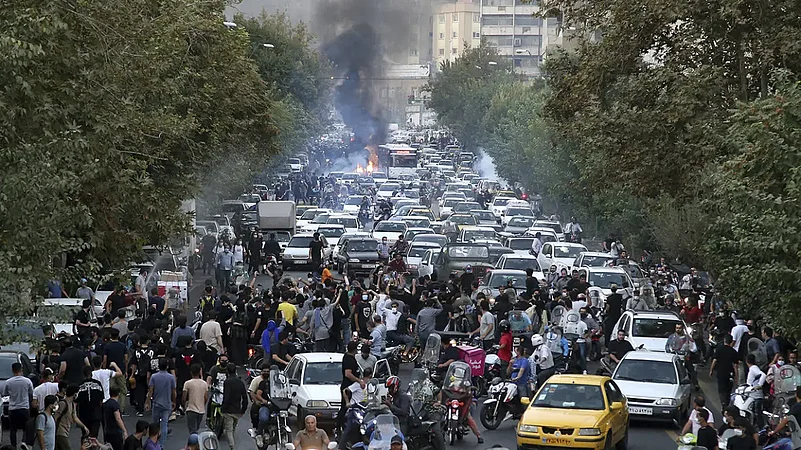At least 26 people have died in nationwide protests in Iran over the death of a young women over the country's hijab rules.
Iran's government is struggling to contain protests over the custodial death of 22-year-old Mahsa Amini. She was detained by Iran's 'morality police' for showing too much hair when she was out with her brother. She was allegedly beaten in police custody, following which she died in a hospital.
Protests have since erupted in about 80 cities and towns in Iran. Women have publicly burnt their hijabs —head coverings— and have cut their hair in protests against the restrictions imposed on them.
Advertisement
Mahsa Amini's death and Iran's hijab rules
Mahasa Amini, 22, was a native of Iran's Kurdistan. She was arrested and beaten for allegedly violating Iran's hijab rules.
Iran is an Islamic country and a strict interpretation of Islamic law Sharia governs people's lives in the country. It dictates that women in public are required to wear hijabs —head coverings— and long loose-fitting clothes that are neither tight nor revealing of their skin.
Such laws have been in place since the 1979 Islamic Revolution of Iran which overthrew the liberal monarchy in the country. Prior to the Islamic Revolution, women in Iran dressed liberally, and photographs from the period of women in skirts and swim suits are available on the internet.
Advertisement
The BBC reports, "Officers [of morality police] have the power to stop women and assess whether they are showing too much hair; their trousers and overcoats are too short or close-fitting; or they are wearing too much make-up. Punishments for violating the rules include a fine, prison or flogging."
Iran rocked by largest protests in years
Thousands of of protesters, mostly women, have taken to streets in the country after Amini's death, chanting anti-government slogans that target the core of the Islamic regime and its Supreme Leader Ayatollah Ali Khamenei.
The death toll in the violent clashes with security forces has reached as high as 26, Iranian state TV indicated on Friday. The unrest, said to be the worst in recent years, has spread to about 80 Iranian cities and towns. The state media report added that at least five security personnel have also been killed and several others injured while trying to confront protesters in Mashhad, Quchan, Shiraz, Tabriz, and Karaj.
Amini's death has fuelled an outpouring of long-simmering anger over restrictions on personal freedoms in the Islamic nation of Iran.
In the past days, some protesting women have set their headscarves on fire on the streets in what can be described as an unprecedented act of disobedience, while men burned banners of the Supreme Leader in several towns including religious cities of Qom and Isfahan.
Protesters also tore and burned posters of Qaseem Soleimani —the Revolutionary Guard commander who was killed in a US drone strike in January 2020— in his hometown Kerman. He is celebrated as a symbol of the Iranian regime's strategic power projection in Syria and Iraq.
Advertisement
While the systematic corruption has torn the economic fabric of Iran which is already crippled by stringent US sanctions, social injustice adds fuel to the flames of discontent. Anti-government protesters allege that technocrats are marginalised in favour of religious socialites and connections overshadow credentials and qualifications for professional progress. Debilitating inflation and unemployment are affecting every family and class. Class gap widens every day and more people feel helpless in the face of deteriorating, they allege.
It is in this climate that social coherence is building among the suppressed and overlooked majority in Iran.
This is the fifth wave of generational mass protests the Islamic republic has witnessed since its inception in 1979. The earlier wave of protests was in 2019 when hundreds were killed.
Advertisement
The ongoing demonstration is dubbed by some as an act of feminist activism triggered by public demand to defend women’s rights. Iranian men also stand shoulder-to-shoulder with their mothers, sisters, daughters, wives, and lovers to see it through.
Defiance of the Iranian state
Women celebrate their dream of freedom by dancing and singing while throwing their headscarves to the fire and grieve the death of Amini as well as other protesters as they cut long locks; while men stand guard.
A female reporter on Islamic TV Channel of Yazd County took off her scarf in front of camera and another national TV host was laid off and his show suspended due to his support of protests.
Advertisement
A day after Amini’s death shops and businesses in every city across the whole county of Kurdistan went on a strike, despite threats made by security forces. Two days later Tehran Bazaar joined the strikes.
During the protests, universities, including University of Tehran and Shahid Beheshti, were at the forefront of unrest with students chanting the most radical slogans such as “Mullahs should sod off”.
(With AP inputs)




















